Author: Jake Huolihan
What makes a lager a lager? An ale an ale? Some might contend it’s the perceived character of the finished beer, that regardless of ingredients or process, if it tastes like a Pilsner then it’s a Pilsner. However, those of a perhaps more traditional persuasion may be wont to argue a beer’s style is determined by the way it was made– a lager can only be a lager if it’s fermented with a specific type of yeast and cold conditioned, whereas an ale is warm fermented with a different species of yeast.
What, then, of the blasphemers who insensitively label lager those beers they made using ale yeasts? And how about this trend of typical ale styles such as hoppy IPA being fermented with lager yeast strains– is it really an India Pale Lager? If what most of us have been taught about the differences between s. cerevesiae and s. pastorianus is true, distinguishing a beer fermented with an ale yeast from a similar beer fermented with a lager strain ought to be easy as pie. Let’s see!
| PURPOSE |
To evaluate the differences between an American Pale Ale fermented at the same temperature with either Safale US-05 ale yeast or Saflager W-34/70 lager yeast.
| METHODS |
For this xBmt, I wanted to brew a beer that would be tasty as either an ale or a lager, assuming the variable had an impact, and ultimately settled on Tiny Bottom Pale Ale with the only modification being the yeast strain.
Tiny Bottom pAle Lager
Recipe Details
| Batch Size | Boil Time | IBU | SRM | Est. OG | Est. FG | ABV |
|---|---|---|---|---|---|---|
| 5.5 gal | 60 min | 34 | 7.3 SRM | 1.046 | 1.008 | 4.99 % |
| Actuals | 1.046 | 1.008 | 4.99 % | |||
Fermentables
| Name | Amount | % |
|---|---|---|
| Pale Malt (2 Row), Rahr | 8.501 lbs | 78.14 |
| Caramel/Crystal Malt - 15L | 11.99 oz | 6.89 |
| Vienna Malt | 11.99 oz | 6.89 |
| Victory Malt | 9.03 oz | 5.19 |
| Caramel/Crystal Malt - 60L | 5.04 oz | 2.9 |
Hops
| Name | Amount | Time | Use | Form | Alpha % |
|---|---|---|---|---|---|
| Magnum | 16 g | 60 min | Boil | Pellet | 11.6 |
| Perle | 14 g | 25 min | Boil | Pellet | 8.6 |
| Fuggles | 14 g | 10 min | Boil | Pellet | 4.4 |
| Fuggles | 15 g | 2 min | Boil | Pellet | 4.4 |
Yeast
| Name | Lab | Attenuation | Temperature |
|---|---|---|---|
| Safale US-05 OR Saflager W-34/70 | Fermentis | 81% | 64.4°F - 78.8°F |
Notes
| Water Profile: Ca 50 | Mg 0 | Na 8 | SO4 75 | Cl 36 |
Download
| Download this recipe's BeerXML file |
When brew day arrived, I began by heating the full volume of water, which I’d adjusted to my desired profile, to the appropriate strike temperature.
As the water was coming to temperature, I measured out and milled the grains.
When the water was slightly warmer than strike temperature, I transferred it my converted cooler MLT and let it preheat for a bit before mashing in to hit my target temperature.
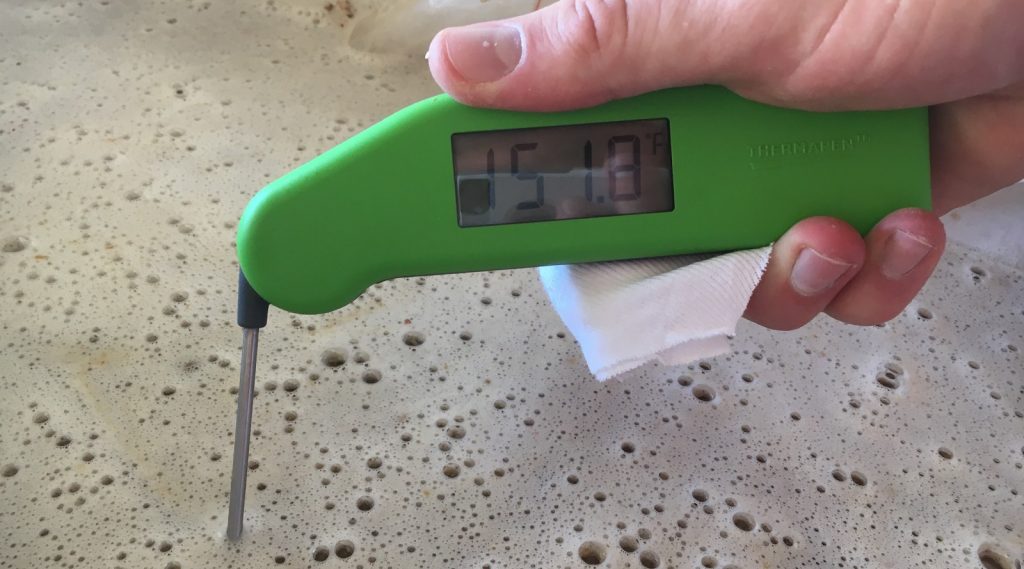
Following a 60 minute rest, I used the batch sparge method to collect the full volume of sweet wort.
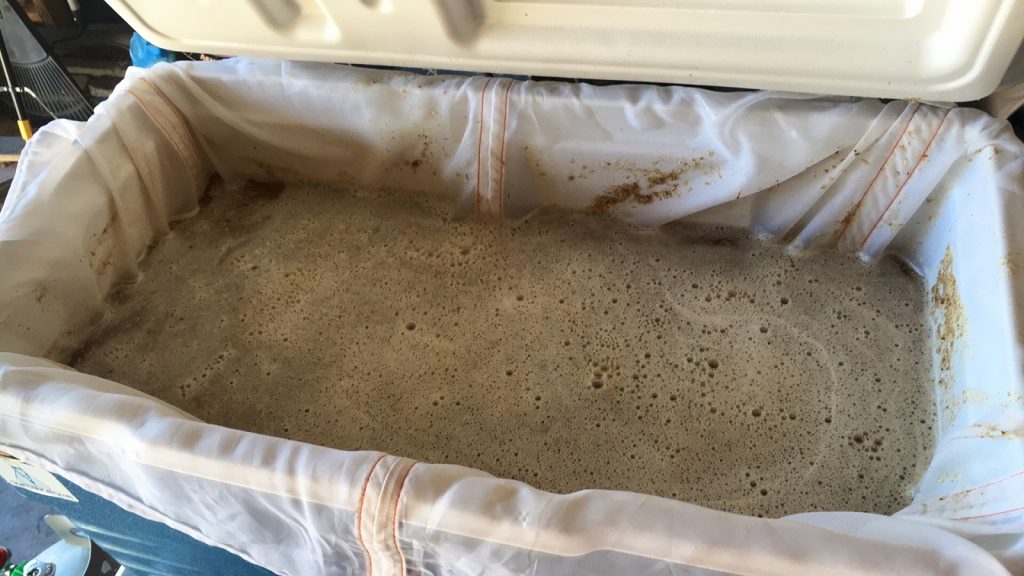
The wort was then boiled 60 minutes with hops added as laid out in the recipe.
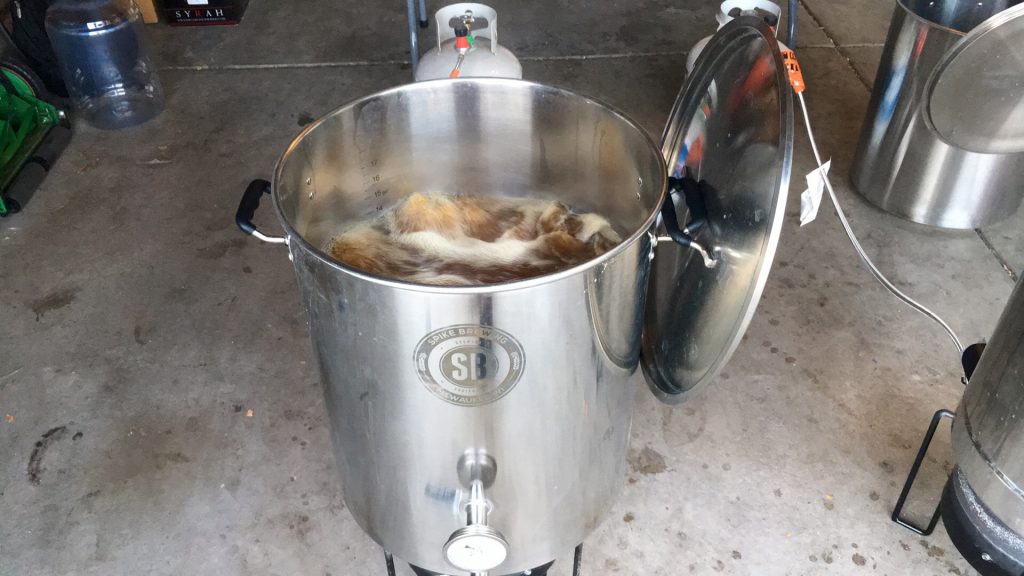
At the conclusion of the boil, I quickly chilled the wort to pitching temperature.

A hydrometer measurement at this point showed I’d come in a few points lower than I was planning, but nothing too worrisome.
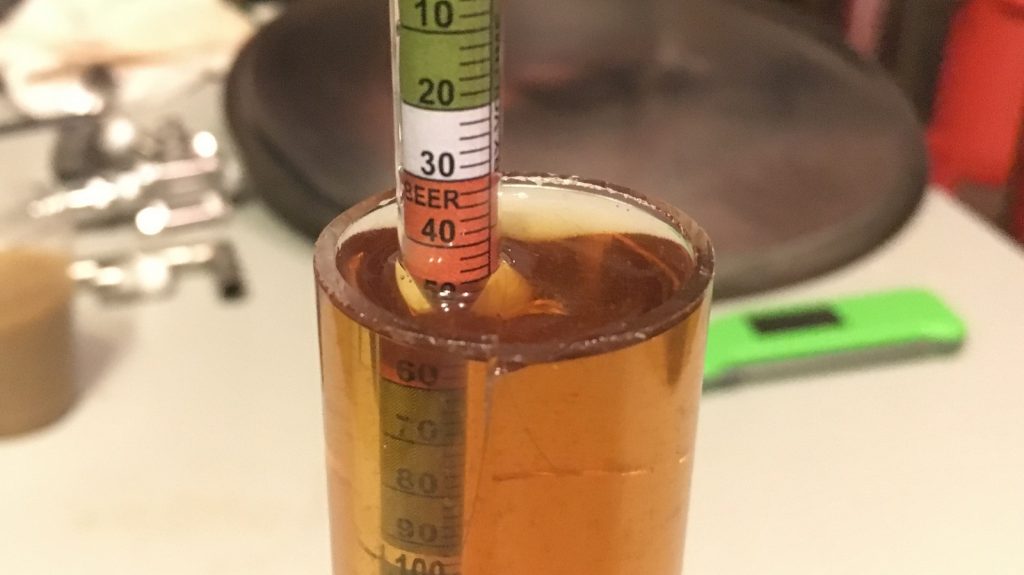
I split the wort equally between identical fermentors and placed them in my fermentation chamber controlled to my desired fermentation temperature of 66°F/19°C. I opted to ferment these beers at this temperature due to previous xBmt results showing a beer fermented warm with W-34/70 was not reliably distinguishable from the same beer fermented cool. I rehydrated 1 pack each of Safale US-05 and W-34/70 before pitching then returned 24 hours later to observe both beers actively fermenting.
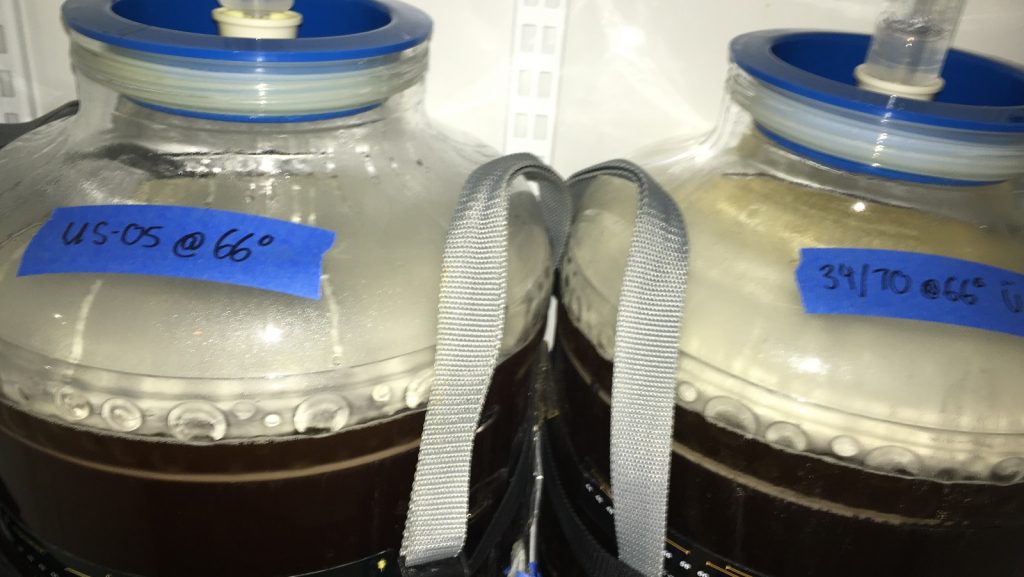
I expected to see some differences, but at 2 days post-pitch, things were looking very similar.
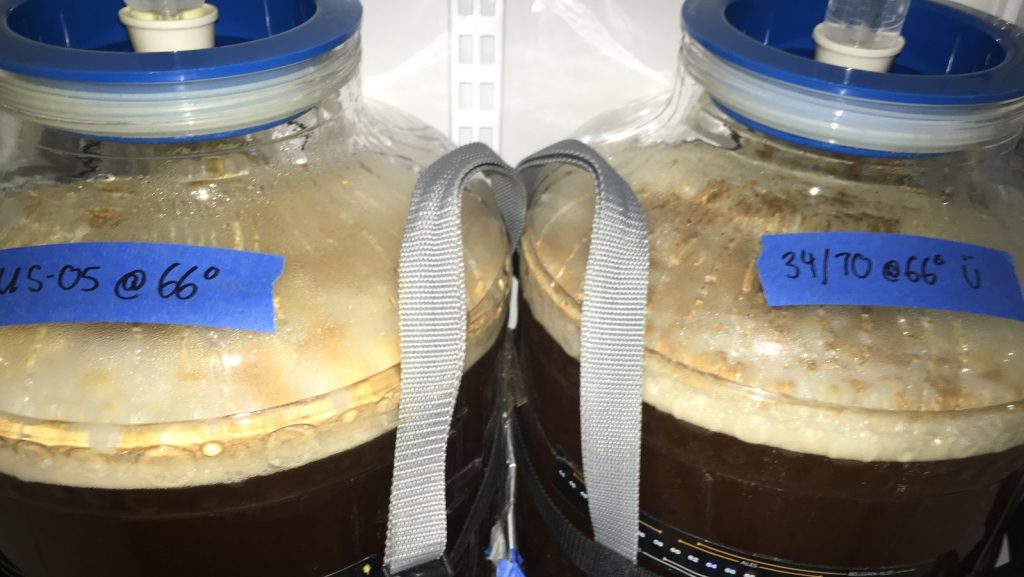
A week into fermentation, I noticed the US-05 batch continued to show signs of activity while activity in the W-34/70 beer appeared to be slowing down. Moreover, the kräusen ring on in the US-05 fermentor was notably higher than the one in the W-34/70 fermentor.
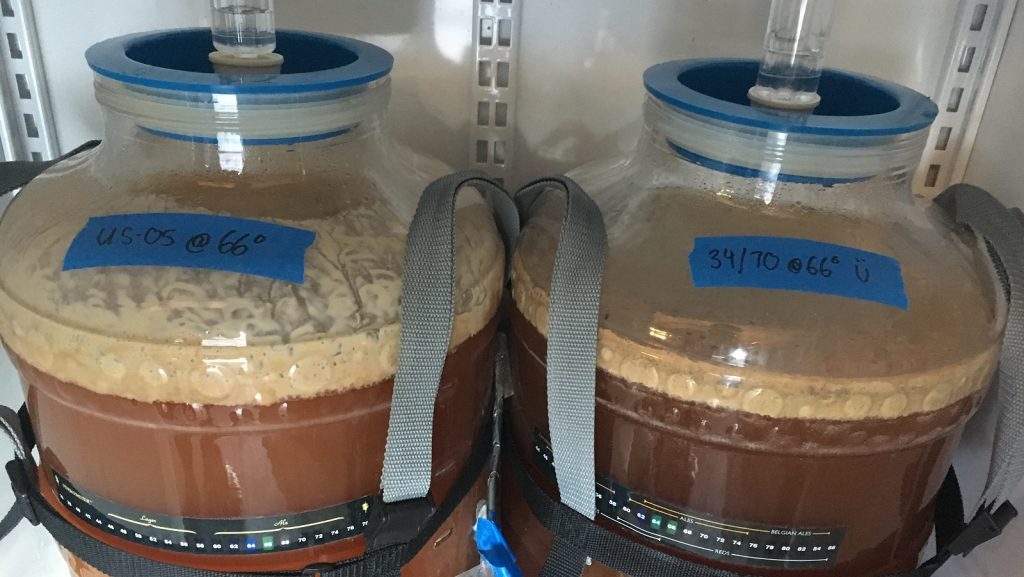
All signs of fermentation had ceased by 10 days post-pitch, at which point I took hydrometer measurements that showed both beers had attenuated to the same FG.
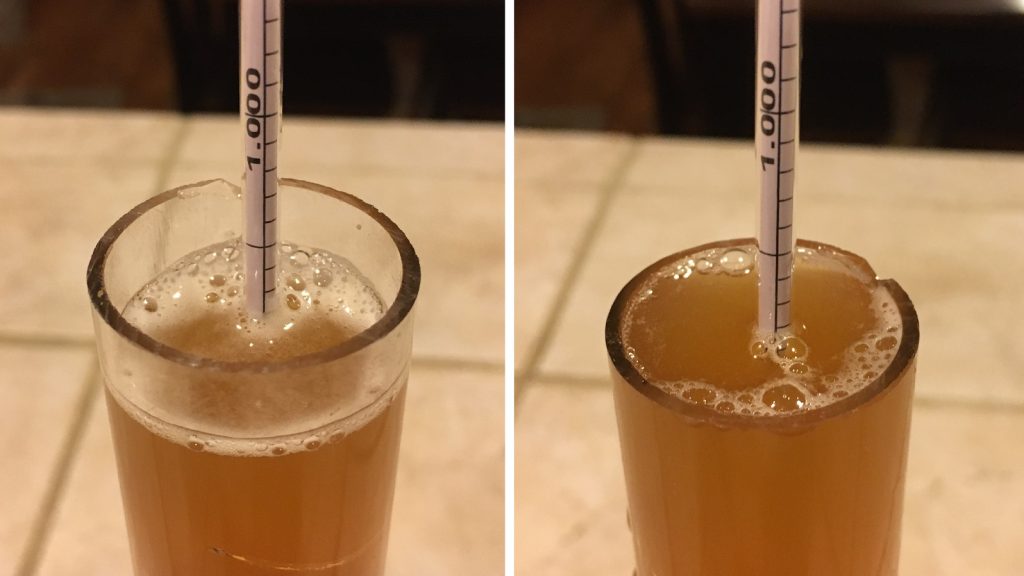
After a few more days at fermentation temperature and another hydrometer measurement ensuring no change in SG, the beers were then cold crashed, fined with gelatin, and kegged.
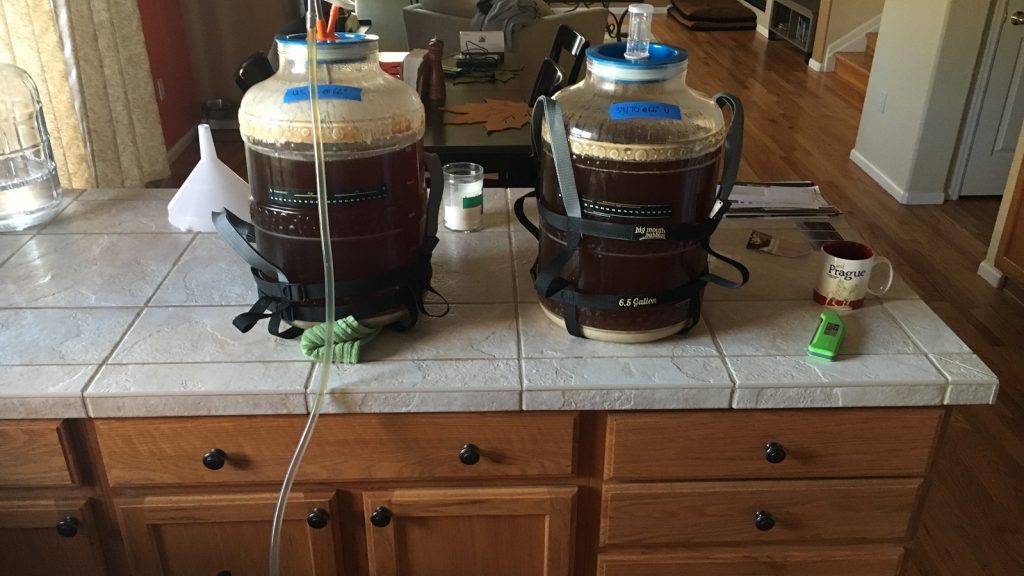
After a brief period of burst carbonation and cold conditioning in my keezer, the beers were ready to be served to unsuspecting tasters.
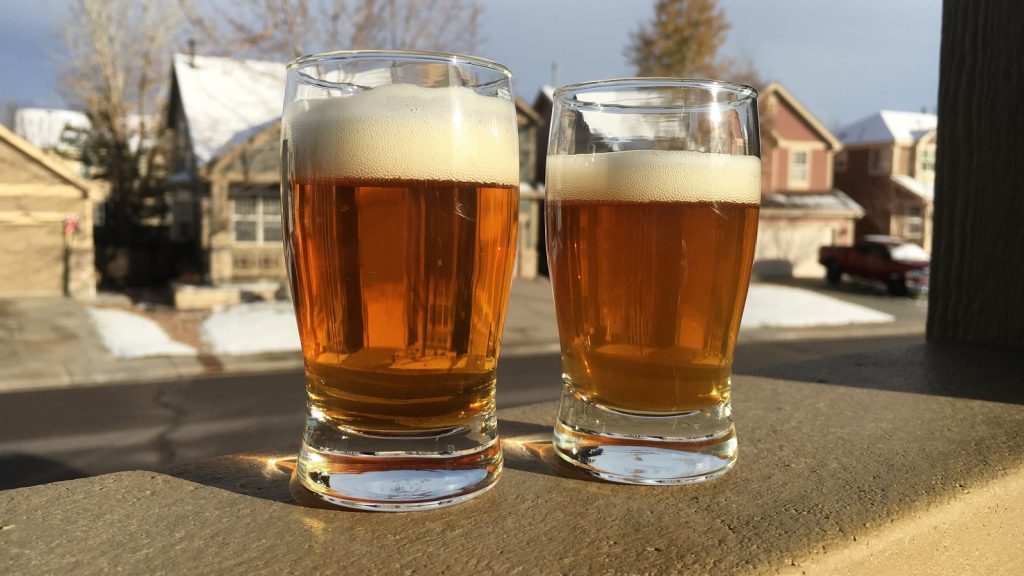
| RESULTS |
A panel of 34 people with varying levels of experience participated in this xBmt. Each taster, blind to the variable being investigated, was served 1 sample of the beer fermented with Safale US-05 and 2 samples of the beer fermented with Saflager W-34/70 in different colored opaque cups then instructed to select the unique sample. While 17 correct selections would have been required to achieve statistical significance, a total of 25 tasters (p<0.05; p=0.000002) chose the different beer, suggesting participants were indeed capable of reliably distinguishing an American Pale Ale fermented with US-05 from one fermented with W-34/70.
The 25 participants who made the correct selection in the triangle test, still blind to the variable in question, were instructed to compare only the 2 different beers and asked about their preference. In all, 9 tasters reported preferring the US-05 beer, 11 said they liked the W-34/70 beer more, 4 had no preference despite noting a difference, and 1 taster felt there was no difference between the beers.
My Impressions: These beers were perhaps the easiest for me to distinguish since I’ve been doing xBmts, to the point I was able to very quickly identify the unique sample in multiple triangle tests by aroma alone. To my senses, the beer fermented with W-34/70 had what I expect from a lager beer, namely a very clean fermentation character with a slight hint of sulfur that emphasizes crispness. I perceived the US-05 fermented beer had a much more noticeable fruity note with a touch of spice in the background. Both beers were quite enjoyable, but if forced to choose, the batch fermented with W-34/70 gets my vote.
This being my first time fermenting W-34/70 at ale temperature, I must say I was utterly shocked with how clean and lager-like the resultant beer was, no different than my experience fermenting with it at more traditional lager temperatures. Furthermore, I now understand the love Tiny Bottom Pale Ale gets from those who brew it! Focused more on being approachable and balanced than extreme in any direction, the beer had a really nice malt character that supported the Fuggle hop flavor beautifully. I definitely plan to brew this one again!
| DISCUSSION |
The fact tasters were able to tell apart beers fermented with either Safale US-05 or Saflager W-34/70 isn’t terribly shocking on its own and serves to validate that different strains, or in the case different species, of yeast produce different character in beer. Saflager W-34/70, sourced from the Weihenstephaner brewery in Bavaria, is a used by brewers around the world to produce crisp and clean lagers, while Safale US-05, purportedly an isolate of the “Chico” strain sourced from Sierra Nevada Brewing, is very popularly used to produce crisp and clean ales.
What I found most intriguing about these results is the fact the beer fermented with Saflager W-34/70 at ale temperature maintained a clean, lager-like character with no notable esters or other flaws expected from fermenting a lager strain too warm. Even more curious is the fact the beer fermented with W-34/70 won the overall preference of those participants who were correct on the triangle test, which at the very minimum suggests the quality was at least inline with that of the US-05 batch. Ultimately, these results leave me even more confident that Saflager W-34/70 is a robust strain capable of producing deliciously clean lager as well as ale, and I certainly plan to continue using it in less conventional ways!
If you have experience with either of these yeast strains or thoughts about this xBmt, please don’t hesitate to share in the comments section below!
Support Brülosophy In Style!
All designs are available in various colors and sizes on Amazon!
Follow Brülosophy on:
FACEBOOK | TWITTER | INSTAGRAM
If you enjoy this stuff and feel compelled to support Brulosophy.com, please check out the Support Us page for details on how you can very easily do so. Thanks!


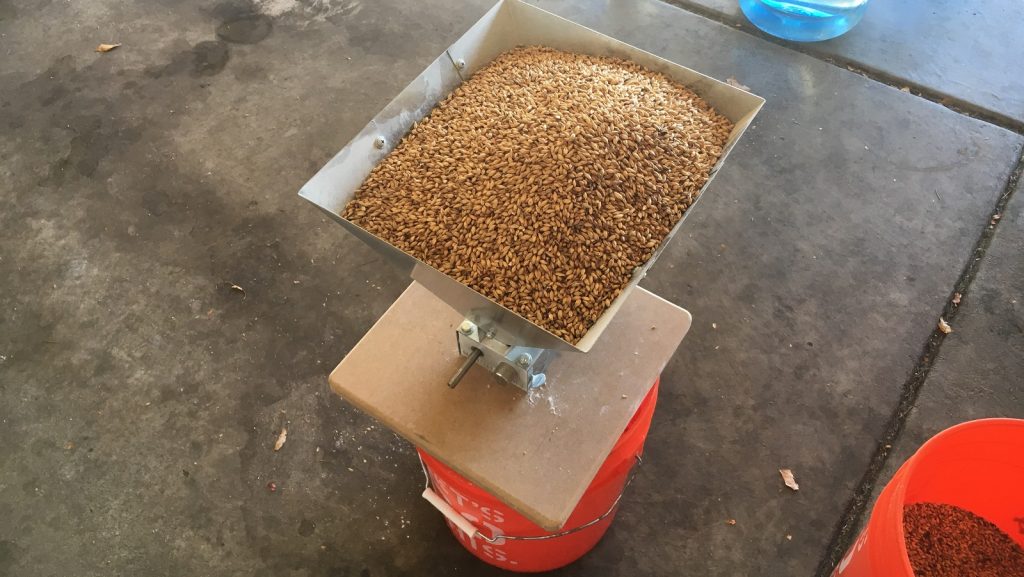










38 thoughts on “exBEERiment | Yeast Comparison: Safale US-05 vs. Saflager W-34/70 In An American Pale Ale”
Wow, truly fascinating…guessing you only pitched 1 pack of yeast each?
Yes one sachet each
Why did you use only 1 pack of W-34/70, when normally you would require 2 packets for 5 gallons (and usually 2 packets are used in your other xbmts)?
Looks like a 6-7g batch split into smaller fermenters…?
If you read Fermentis instructions, it is necessary to increase the pitch rate only when pitching at 12° Celsius. Another good reason to try this warmer fermentation approach
I use 1 sachet per 23l at 19c on the assumption that the higher pitch rate is only required for low temperatures. It works just fine.
As I stated above, your assumption is correct, as it can be found in Fermentis specs/instructions sheet
Cool. The data sheets I had access to didn’t mention usage at around 19c hence the assumption. Plenty of info for 12-15c and below 12c.
I live and learn 😉
It appears in the photo that the W-34/70 beer had a noticeable chill haze; is that correct?
Since they were both split off the same kettle my hunch is it’s not chill haze.
Has the 34/70 batch dropped clear as the beers have sat in the keg?
It’s been a while since this was on tap. I believe it was clear prior to kicking. I am guessing the haze was due to yeast kicked up during kegging
Interesting! As I was reading, I was thinking, “if this doesn’t show a significant result, this is ridiculous.” they give such different character!
I just put an ipa in my fermentation chamber split with us-05 and 34/70 but I’m fermenting it at 54. Can’t wait to taste mine now
Great xbmt. I have been a proponent of “off style” brewing for years. I often use 34/70 for “IPA” , “pale ale” and for our “amber/mild”. I searched for years for an ale strain that would produce a lager like character in my finished beers. I, like many others thought you had to ferment lager cool, or cold. Since the Xbmt with 34/70 fermented at 70 F… I have started using it for all kinds of beers. (It is especially awesome in a malty, slightly roasty amber)
I think if I have any things I’d like tested, inspired by this xbmt, I would suggest comparing 34/70 to K-97. K-97 produces only 23 ppm of esters in a 1.050 wort. I would also suggest that consistent fermentation temperature seems to be critical with 34/70. You can ferment 34/70 warm, but if your temperature swings up and down, you will have noticeable off flavors. Of course that is only from empirical observation, not from any real data collection.
And what about these two strains fermented on cold conditioning (10º C) ?
Great experiment!
Have any idea of how to measure high alcohols? I gess only by the off flavors in the palate.
Bruno
Interesting. Correct me if I’m wrong, didn’t the German’s “stumble” upon laggering by accident? Weren’t they simply storing their beers in cool caves during the hot summer to stave off spoilage and, as nature would have it, some yeast evolved the ability to survive and multiply at those lower temperatures? If that’s the case, it makes sense that those “cool fermenting yeast” should work at higher temps.
I do agree with counterbrew, I brewed a Budvar clone that tasted like Nyquil thanks to a power outage.
Any chance you could include both
Imperial and metric measurements in your recipes?
Yep, but not consistently across grains and hops.
He used lb, oz and gr. 🙂
Would be interesting to compare the same lager yeast fermented at cold temperatures vs one fermented warm.
It’s been done… 3 times 🙂
Ferm Temp xBmt w/ WLP800
Ferm Temp xBmt w/ W-34/70
Ferm Temp xBmt w/ W-34/70 at higher temp difference
Great xbmt! Just for clarification, you fermented for ~14 days at 66F ?
Fascinating experiment, would love to see more yeast comparisons.
Well it may be that schwartzbier was an ale in its past: http://barclayperkins.blogspot.co.uk/2017/03/german-top-fermenting-beers-classified.html
great write up, but i’d love to see the samething at lower temps. given my experiences with US-05 being more prone to Diacetyl at these lower temps, meaning a D-rest is more important in this case.
Made the same experiment a few months ago. With the same two yeast stains. But added an extra variable: pale ale OR pilsner malt base.
4 permutations (malt/yeast): Ale/ale – ale/pils – pils/ale – pils/pils.
Ferment at 20 C.
All four beers perfectly drinkable. But the favorites were ale/ale and pils/pils.
Love the write up. Wondering though that if you thought about how you fermented with both being at 66F. Saflager ideal temp is 53.6-59 where as safale is 59 – 71.6. With a 66F Temp it looks like your experiment is no properly testing the yeast strain at it’s “working range.” I am still interested in this experiment but would like to see what the difference would be between ale and lager comparison done by actually fermenting the appropriate way.
I think part of the point was to compare both at ale temps. Besides, previous XBMTs seemed to indicate people couldn’t tell the difference between cooler and warmer W-34/70 ferment temps.
Having read this I’m brewing a hoppy session IPA tomorrow but I’m going to pitch W-34/70 and ferment at 19c. Because of the high fermentation temperature I’m pitching at ale rates rather than lager rates. Fingers crossed 🙂
Brewed! You’ll be pleased to know a reasonable amount of trub went in there.
Grist was 91.5% UK Pale Malt, 6% Malted Oats and 1.5% Crystal.
Water profile was UK Bitter – 120ppm Ca, 196ppm SO4, 90ppm Cl
Pitched at 18.3c and allowed a gradual rise to 19c over 36 hours. Now holding at 19c for 4.5 days
3 days in now. The sulphur smell in my garage was somewhat unpleasant but it’s now cleared. Gravity down to 1.008 from 1.043.
About to dry hop at 8g/l with Summer, Ella and Mosaic pellets.
OK, results are in. Great, clean flavoured low strength IPA. Considering the rampant dry hopping it’s quite clear.
No off flavours, no ale yeast type flavours, just clean so the hops shine through.
Still gassing up in the kegerator but I think this is a winner. I’m going to try Saflager at 19c on some other recipes.
Thanks for putting me onto this.
Idea for another experiment with the same yeast strains: high gravity wort, above 20 Plato.
This study: https://link.springer.com/article/10.1007/s12257-011-0658-6 shows, that differences between ale and lager yeast in terms of flavour volatiles are decreasing with increasing gravity. For me the big question is: if we make a wort for imperial/baltic porter, with lots of munich, crystal and black malts, ferment it with lager vs ale yeast and then cold condition for few months, will they be distinguishable in a sensory test?
I’m brewing a 5.5 gallon batch of 1.050 altbier tomorrow using 34/70 for the first time. I’m planning to pitch/brew in the low
To mid 60s using my Inkbird and ramping up to 66-68f to finish. The main catch here is in using expired yeast (exp 1/2016). Given my conditions above, how many packets of 34/70 should I pitch? 2? 3? Hoping to avoid strong sulfur byproducts if possible.
Thanks !
I’ve never really experimented with expired dry yeast. I’d probably rehydrate two packs just to be safe.
Thanks Jake I just recently brewed a 1.065 Neipa with two similarly expired packets of so4 (unrehydrayed) and it brought fg all the way down to 1.010 fermented in low to mid 60s in about a week. Having never used 34/70 I’m not sure exactly what to expect but based on all of your results I’m excited to see how it works out
34/70 (and S23) are very unique yeasts. If not already emphasized, may I suggest, one should not try this with most other lager yeasts. 34/70 (and S23) are bottom fermenting yeasts but both like it warmer than normal lager yeasts. So your results are not surprising but are somewhat reassuring.Firstly,with such clear results from the blind tasters .
One question I have, is with respect S23, (not 34/70). I have used S23 a lot…but at higher end temps say 19C and pitched at 25C and I was getting sort of peppery flavors….like in Belgium beers. My friends liked the beer (it was free!!) but it just wasn’t the lager flavor I was intending. Anyway after seeing posts and having arguments with cold pitching/fermenting brewers about esters/ temperature I then did a lager where dropped the temp down to 15C using S23 and goodbye pepper. I am doing a lager with 34/70 at the moment and have pitched at 19C and dropped to 12.5 slowly after 12 hours.So I will be interested in whether that peppery flavor is still there. But its a different yeast so it won’t prove much. Interested in the sulphuryness [sic] of the beer using 34/70…seemingly more evident in the higher temp fermented beers especially as the warm in the glass.. Love your experiments. A true myth buster. Cheers